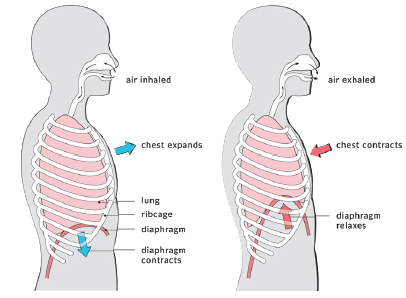Diaphragmatic breathing helps individuals use their diaphragm correctly while breathing and enhances oxygen exchange (Cleveland Clinic, 2020). With age, stress, poor posture, and illness breathing changes and becomes shallow with increased reliance on accessory muscles. Implementing diaphragmatic breathing may help improve oxygen delivery throughout the body, use less effort and energy to breathe, and decrease overall oxygen demand.
Breathing
During Inhalation:
• Diaphragm contracts moving downward and flattening.
• Diaphragm movement creates increased space and negative pressure, allowing lungs to fill and chest to expand.
During Exhalation:
• Diaphragm relaxes moving upward in the chest cavity.
• Air is forced out of the lungs and chest contracts.

Postural Alignment: Improvement Directly Impacts Breathing
- During forward head posture, forced vital capacity, expiratory and inspiratory reserve volumes, forced expiratory volume in one second, and peak flow rate were significantly lower than with neutral head position. (Koseki et al., 2019)
- Change from upright head posture to either forward head posture or torticollis (forward head with rotation) had an immediate negative impact on respiratory function. (Zafar et al., 2018)
- Slouched sitting position had a significantly lower sniff nasal inspiratory pressure (SNIP) score compared to upright sitting position, suggesting reduced diaphragm tension and movement due to altered body position. (Albarrati et al., 2018)
PENS Neck and Thorax Protocols
Applied prior to or during diaphragmatic breathing exercise may enhance muscle activation, improve postural alignment and affect respiration.

Diaphragmatic Breathing Training Procedure (Cleveland Clinic, 2020)
Instruct the patient to:
- Lie on back with head on pillow and knees bent
- Place one hand on the upper chest and the other on stomach below the ribs
- Breathe in slowly and deeply through the nose
Hand on chest should remain still, while hand on stomach should rise - Exhale through pursed lips while tightening the abdominal muscles allowing them and the hand on the stomach to fall down to the original position, while the hand on chest remains still
- Duration: 5-10 minutes, several times per day with progression from lying to sitting in a chair
References:
Albarrati, A., Zafar, H., Alghadir, A. H., & Anwer, S. (2018). Effects of Upright and Slouched Sitting Postures on the Respiratory Muscle Strength in Healthy Young Males. BioMed Research International.
https://doi.org/10.1155/2018/3058970
Cleveland Clinic. (n.d.). Diaphragmatic Breathing. Retrieved May 8, 2020, https://my.clevelandclinic.org/health/articles/9445-diaphragmatic-breathing
Koseki, T., Kakizaki, F., Hayashi, S., Nishida, N., & Itoh, M. (2019). Effect of forward head posture on thoracic shape and respiratory function. Journal of Physical Therapy Science. 31, 63-68. https://doi.org/10.1589/jpts.31.63
Zafar, H., Albarrati, A., Alghadir, A. H., & Iqbal, Z. A. (2018). Effect of Different Head-Neck Postures on the Respiratory Function in Healthy Males. BioMed Research International. http://doi.org/10.1155/2018/4518269
